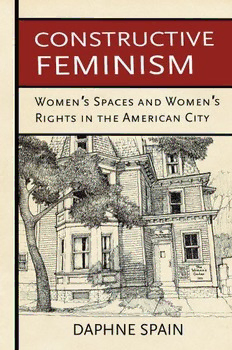
Constructive Feminism: Women’s Spaces and Women’s Rights in the American City PDF
Preview Constructive Feminism: Women’s Spaces and Women’s Rights in the American City
CONSTRUCTIVE FEMINISM CONSTRUCTIVE FEMINISM Women’s Spaces and Women’s Rights in the Americ an C ity Daphne Sp ain CORNELL UNIVERSITY PRESS Ithaca and London Cover illustration: Cambridge Women’s Center, Cambridge, Massachusetts. Drawing by Reed Gyovai Muehlman. Copyright © 2016 by Cornell University All rights reserved. Except for brief quotations in a review, this book, or parts thereof, must not be reproduced in any form without permission in writing from the publisher. For information, address Cornell University Press, Sage House, 512 East State Street, Ithaca, New York 14850. First published 2016 by Cornell University Press First printing, Cornell Paperbacks, 2016 Printed in the United States of America Library of Congress Cataloging-in-Publication Data Names: Spain, Daphne, author. Title: Constructive feminism : women’s spaces and women’s rights in the American city / Daphne Spain. Description: Ithaca : Cornell University Press, 2016. | Includes bibliographical references and index. Identifiers: LCCN 2015038567 | ISBN 9780801453199 (cloth : alk. paper) | ISBN 9781501703201 (pbk. : alk. paper) Subjects: LCSH: Feminism—United States—History— 20th century. | Women’s rights—United States— History—20th century. | Public spaces—United States—History—20th century. | Urban women— United States—History—20th century. | Women and city planning—United States—History—20th century. | Feminism and architecture—United States. | Feminist geography—United States. Classification: LCC HQ1421 .S6753 2016 | DDC 305.42097309/04—dc23 LC record available at http://lccn.loc.gov/2015038567 Cornell University Press strives to use environmentally responsible suppliers and materials to the fullest extent possible in the publishing of its books. Such materials include vegetable-based, low-VOC inks and acid-free papers that are recycled, totally chlorine-free, or partly composed of nonwood fibers. For further information, visit our website at www.cornellpress.cornell.edu. Cloth printing 10 9 8 7 6 5 4 3 2 1 Paperback printing 10 9 8 7 6 5 4 3 2 1 For Steven Proposed Equal Rights Amendment to the US Constitution “Equality of rights under the law shall not be denied or abridged by the United States or by any State on account of sex.” 1923: First introduced in Congress by Alice Paul of the National Woman’s Party 1972: Passed both houses of Congress; sent to states for ratification 1982: Ratification failed, three states short of the required thirty-eight states “If you pick up any constitution written since 1950, any place in the world, there will be a provision on the equal citizenship stature of men and women. It’s not in our constitution. I would like to see a statement of women’s full citizenship in the constitution on par with our freedom of speech, freedom of religion. It’s a basic tenet of our society.” —Supreme Court Justice Ruth Bader Ginsburg, September 12, 2014, presentation at George Washington University, Washington, DC Contents Preface ix Acknowledgments xvii Introduction: Spatial Consequences of the Second Wave 1 1. Feminist Practice: Social Movements and Urban Space 25 2. Women’s Centers: Nurturing Autonomy 50 3. Feminist Bookstores: Building Identity 84 4. Feminist Health Clinics: Promoting Reproductive Rights 111 5. Domestic Violence Shelters: Protecting Bodily Integrity 140 6. After the Second Wave: Necessary Spaces 168 Appendixes A: Data Sources for Figure 3 187 B: Women’s Centers, 1973 190 C: Feminist Bookstores, ca. 1980 196 D: Feminist Health Clinics, 1975 201 Notes 203 Index 251 Preface In 1975 the filmmaker Sheila Ruth directed and coproduced a video titled Constructive Feminism. In it she documented the reno- vation of a three-story abandoned warehouse on Spring Street in Los Angeles that was to become the second home of the Woman’s Building.1 (See figure 1.) The organization’s first home, and the organization itself, came about as a result of the Los Angeles County Museum of Art’s 1970 exhibition Art and Technology, which included only male artists. The artist Judy Chicago, the graphic designer Sheila Levrant de Bretteville, and the architectural historian Arlene Raven were outraged. They fought back by establishing, three years later, the first Woman’s Building on Grandview Avenue. Its purpose was to serve as “a public center for women’s culture”; the name was chosen to honor the Woman’s Building at the 1893 World’s Columbian Exposition in Chicago. Aware that much of women’s contribution to the arts had been lost to history, the founders, intent on nurtur- ing women’s “insurgent muse,” were determined to resurrect it.2 The renovated building on Spring Street housed the Feminist Studio Workshop, galleries for women’s art, a print shop, a branch of Sisterhood Bookstore, offices, and a restaurant. The entire third floor was an open space where hundreds of lesbians once held a Dyke of Your Dreams Day dance to celebrate Valentine’s Day. In 1978 members of the Feminist Studio Work- shop hoisted a thirteen-foot-high papier-mâché-and-concrete model of a nude woman to the roof as one of a series of sculptures created by the author Kate Millett while she was an artist in residence. Before the Building closed in 1991, Adrienne Rich, Rita Mae Brown, Ntozake Shange, and many other emerging artists had read their new works to enthusiastic audiences.3 The Woman’s Building and the title of the documentary capture the spirit of this book. I wanted to find ways in which the mid-twentieth century feminist movement known as the Second Wave created new uses for urban space in order to nurture women’s growing autonomy. Art spaces were one example, but more common were the women’s centers, bookstores, health clinics, and domestic violence shelters that appeared for the first time in the early 1970s. In remembering her days as a staff member at the Woman’s Building, the performance artist Terry Wolverton acknowledged that she
